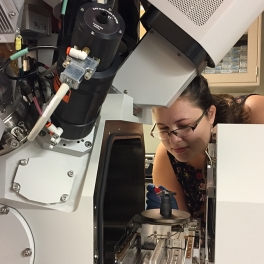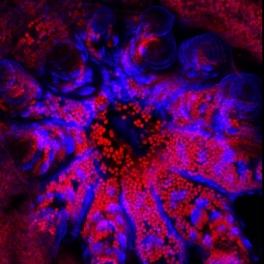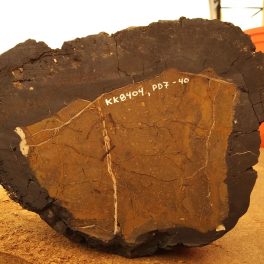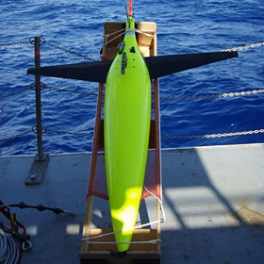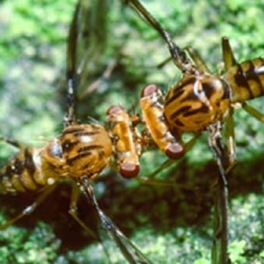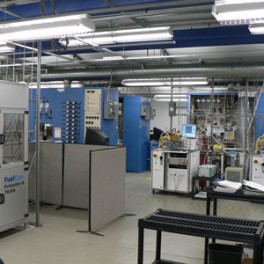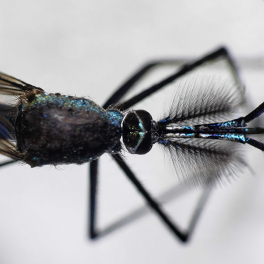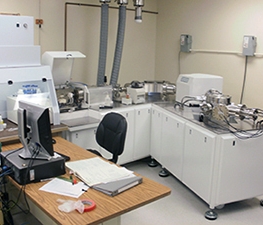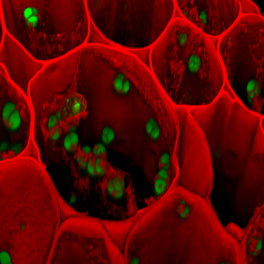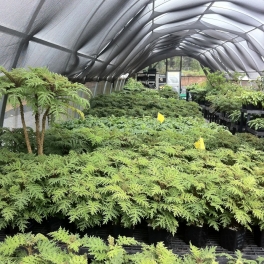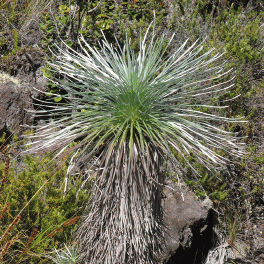-
 Advanced Electron Microscopy Center (AEMC) The Advanced Electron Microscopy Center (AEMC) is a service facility that provides sample preparation and electron and ion microscopy imaging and analysis to the University of Hawai‘i research community as well as other research institutions and industrial clients.
Advanced Electron Microscopy Center (AEMC) The Advanced Electron Microscopy Center (AEMC) is a service facility that provides sample preparation and electron and ion microscopy imaging and analysis to the University of Hawai‘i research community as well as other research institutions and industrial clients. -
 Biogeochemical Stable Isotope Facility The Biogeochemical Stable Isotope Facility measures stable isotopes of carbon, nitrogen, hydrogen, and oxygen in a variety of solid, liquid, and gas samples. It offers a broad list of analyzing services, such as the isotopic composition of nitrates, amino acids, individual compounds, and carbonates.
Biogeochemical Stable Isotope Facility The Biogeochemical Stable Isotope Facility measures stable isotopes of carbon, nitrogen, hydrogen, and oxygen in a variety of solid, liquid, and gas samples. It offers a broad list of analyzing services, such as the isotopic composition of nitrates, amino acids, individual compounds, and carbonates. -
 Biological Electron Microscope Facility (BEMF) Centrally located in Snyder Hall on the UH Mānoa campus, the BEMF houses one of only two transmission electron microscopes in the state, and is one of a diminishing number of scanning and transmission electron microscope facilities nationwide.
Biological Electron Microscope Facility (BEMF) Centrally located in Snyder Hall on the UH Mānoa campus, the BEMF houses one of only two transmission electron microscopes in the state, and is one of a diminishing number of scanning and transmission electron microscope facilities nationwide. -
 Confocal Microscope Facility The Confocal Microscope Facility at the Hawai‘i Institute of Marine Biology (HIMB) is home to the Zeiss LSM710 laser-scanning confocal microscope. The microscope has a multitude of functions for high-resolution fluorescent imaging and analyses and is especially suited for live cell imaging of relatively thick samples.
Confocal Microscope Facility The Confocal Microscope Facility at the Hawai‘i Institute of Marine Biology (HIMB) is home to the Zeiss LSM710 laser-scanning confocal microscope. The microscope has a multitude of functions for high-resolution fluorescent imaging and analyses and is especially suited for live cell imaging of relatively thick samples. -
 Electron Microprobe Facility The JEOL Hyperprobe JXA-8500F is a state-of-the-art system for acquiring major, minor, and trace element concentrations in minerals, glasses, and other solid materials, as well as high-resolution imaging using secondary-electron, backscattered-electron, cathodoluminescence, and WDS X-ray signals.
Electron Microprobe Facility The JEOL Hyperprobe JXA-8500F is a state-of-the-art system for acquiring major, minor, and trace element concentrations in minerals, glasses, and other solid materials, as well as high-resolution imaging using secondary-electron, backscattered-electron, cathodoluminescence, and WDS X-ray signals. -
 Evolutionary Genetics Core Facility Providing technical genomic services and support for the faculty and students at HIMB, UH, and other world-wide institutions. The GCF provides access to various instrumentation and equipment and offers genomic services, including next generation sequencing.
Evolutionary Genetics Core Facility Providing technical genomic services and support for the faculty and students at HIMB, UH, and other world-wide institutions. The GCF provides access to various instrumentation and equipment and offers genomic services, including next generation sequencing. -
 Flow Cytometry Facility Providing state of the art instrumentation for analyzing and sorting particles. Flow cytometers detect particles based on their size and fluorescence, allowing multiple populations to be separated visually and physically for cells that are 0.2 - 200 µm in diameter in concentrations as low as 1000 cells/ml.
Flow Cytometry Facility Providing state of the art instrumentation for analyzing and sorting particles. Flow cytometers detect particles based on their size and fluorescence, allowing multiple populations to be separated visually and physically for cells that are 0.2 - 200 µm in diameter in concentrations as low as 1000 cells/ml. -
 Geological Sample Facility (DredgeBase)
Geological Sample Facility (DredgeBase)This facility holds a collection of seafloor rocks and drill cores from sites throughout the Pacific. While dredged material dominates the archive, many samples were collected by submersibles and robotic vehicles. DredgeBase is the interactive search tool developed to peruse the holdings.
-
 Glider Facility The Glider Facility is home to various Seagliders that fly through the water, taking oceanographic measurements at a fraction of the cost of traditional methods. The gliders can survey along a transect, profile at a fixed location, and can be commanded to alter their sampling strategies throughout a mission.
Glider Facility The Glider Facility is home to various Seagliders that fly through the water, taking oceanographic measurements at a fraction of the cost of traditional methods. The gliders can survey along a transect, profile at a fixed location, and can be commanded to alter their sampling strategies throughout a mission. -
 Hawaii Tree Snail Conservation Laboratory The core function of this lab is captive breeding, care and maintenance of rare Hawaiian tree snails. We are currently working with 10 species — members of the endemic subfamily Achatinellinae — all of which are Federally listed as endangered.
Hawaii Tree Snail Conservation Laboratory The core function of this lab is captive breeding, care and maintenance of rare Hawaiian tree snails. We are currently working with 10 species — members of the endemic subfamily Achatinellinae — all of which are Federally listed as endangered. -
 Hawaiian Drosophila Research Stock Center (HDRSC) The HDRSC maintains laboratory colonies of Hawaiian Drosophila species, several of which are listed as endangered. HDRSC maintains colonies of other species that researchers at UH Mānoa and elsewhere are using for specific research projects.
Hawaiian Drosophila Research Stock Center (HDRSC) The HDRSC maintains laboratory colonies of Hawaiian Drosophila species, several of which are listed as endangered. HDRSC maintains colonies of other species that researchers at UH Mānoa and elsewhere are using for specific research projects. -
 Hawai‘i Sustainable Energy Research Facility (HiSERF) Working to accelerate the development of fuel cells for commercial and military operations and evaluating the performance and durability of energy storage technologies in order to reduce Hawai‘i’s use of fossil fuels.
Hawai‘i Sustainable Energy Research Facility (HiSERF) Working to accelerate the development of fuel cells for commercial and military operations and evaluating the performance and durability of energy storage technologies in order to reduce Hawai‘i’s use of fossil fuels. -
 Insectary for Scientific Training and Advances in Research (InSTAR)
Insectary for Scientific Training and Advances in Research (InSTAR)InSTAR aims to create the necessary infrastructure needed for proper insect-rearing conditions. Its goal is to promote research on insect microbiotas and advance research in medical entomology by providing core services and training.
-
 SOEST Laboratory for Analytical Biogeochemistry (SLAB) Providing per-sample measurement capability for solid-phase and dissolved organic and inorganic nutrients (C, P, N, Si), dissolved oxygen, salinity, and cholorphyll-a.
SOEST Laboratory for Analytical Biogeochemistry (SLAB) Providing per-sample measurement capability for solid-phase and dissolved organic and inorganic nutrients (C, P, N, Si), dissolved oxygen, salinity, and cholorphyll-a. -
 Lapidary Facility The Lapidary Facility works to prepare rock samples for petrographic, mineralogical, and geochemical analyses for classroom and research use. The facility also provides a wide range of services for researchers and faculty throughout the University system and the community.
Lapidary Facility The Lapidary Facility works to prepare rock samples for petrographic, mineralogical, and geochemical analyses for classroom and research use. The facility also provides a wide range of services for researchers and faculty throughout the University system and the community. -
 MC-ICP-MS Laboratory Analyzing plasma and isotopes to better understand volcanology and environmental geoscience. The facility uses Nu Instruments HR multi-collector ICP mass spectrometer and offers training, routine isotopic analysis, assistance with analytical protocol and new methods development.
MC-ICP-MS Laboratory Analyzing plasma and isotopes to better understand volcanology and environmental geoscience. The facility uses Nu Instruments HR multi-collector ICP mass spectrometer and offers training, routine isotopic analysis, assistance with analytical protocol and new methods development. -
 Microbial Genomics and Analytical Laboratory (MGAL)
Microbial Genomics and Analytical Laboratory (MGAL)MGAL provides a wide variety of services, such as high-throughput DNA/RNA extractions, amplicon library preparation using the Earth Microbiome Project primers, natural product and small molecule analysis, and culturing and storage of microbial strains.
-
 Microscopy Imaging Center for Research through Observation (MICRO)
Microscopy Imaging Center for Research through Observation (MICRO)Provides researchers with state-of-the-art instrumentation, training and services for high-resolution scanning electron microscopy, transmission electron microscopy, optical, fluorescence, and laser scanning confocal microscopy, and image analysis on a recharge basis.
-
 Olinda Rare Plant Facility (ORPF) This facility is focused on propagation of threatened and endangered plants from the islands of Maui, Moloka‘i, and Lāna‘i. The ORPF staff is currently propagating 34 species and has also begun to out-plant individuals of many of these species back into the natural habitat.
Olinda Rare Plant Facility (ORPF) This facility is focused on propagation of threatened and endangered plants from the islands of Maui, Moloka‘i, and Lāna‘i. The ORPF staff is currently propagating 34 species and has also begun to out-plant individuals of many of these species back into the natural habitat. -
 Volcano Rare Plant Facility (VRPF) On the island of Hawai‘i, this facility was the first mid-elevation nursery dedicated to the propagation of endangered Hawaiian plant species. They use various methods of plant propagation and by maintain a gene bank of plants and seeds to increase plant numbers and preserve genetic diversity
Volcano Rare Plant Facility (VRPF) On the island of Hawai‘i, this facility was the first mid-elevation nursery dedicated to the propagation of endangered Hawaiian plant species. They use various methods of plant propagation and by maintain a gene bank of plants and seeds to increase plant numbers and preserve genetic diversity





